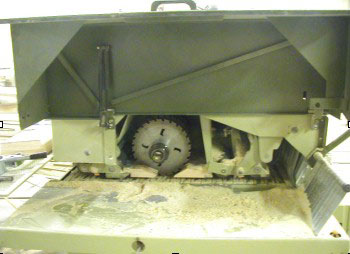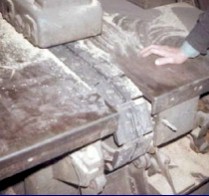Machine Guarding eTool
Saws » Straight-line/Gang Rip Saws

A straight line or gang rip saw is a circular blade machine, usually of the radial design, used for cutting wood across and above the stock. The blade is mounted directly to the motor, which is contained in the moveable ram. The stroke may be manual or powered. The saw blade generally rotates at 3,600 rotations per minute (RPM). Stock is fed in front of the machine on a feed table with rolls and guides and pulled across the stock. After the cut is complete, the blade must return to its original position behind the stock and the stock is repositioned for the next cut.
Operator Involvement
This type of saw requires the operator to position the stock, hold it stationary, and grasp the sawing mechanism.

Potential Hazard
-
Contact with the blade may occur during operation, when the saw is idling, if the return device fails, or if the saw bounces forward from a retracted position.
-
If the saw blade is able to go past the edge of the table, the blade could come in contact with the operator's body.
Solutions
-
Enclose upper half of saw and arbor end with a self-adjusting hood. The hood must drop on top of and remain in contact with the table or stock. When the saw returns to the back of the table, the hood must cover the lower portion of the blade. [29 CFR 1910.213(g)(1)]
-
Ensure that the saw contains an automatic device (such as a counterweight) to return the saw to the back of the table after the cut has been made. [29 CFR 1910.213(g)(2)]
-
Use limit chains or other effective means (for example, extend the table edge) to keep saw from moving beyond the front or back edge of the table. [29 CFR 1910.213(g)(3)]
-
Enclose overhead drive with a fixed guard. [29 CFR 1910.219]
-
The direction of the saw rotation must be clearly marked on the hood and a warning label placed that reads "Danger: Do Not Rip or Plough From This End". [29 CFR 1910.213(h)(5)]
Additional Safety Measures
-
Position the piece to be cut before starting the saw.
-
Stand at the side of the saw blade when the saw is running, and use the hand nearest the handle to operate the saw. (This keeps the operator's body out of the line of the saw.)
-
Keep hands out of the line of the cut.
-
Install a latch with a ratchet release on the handle, non-recoil spring, bumper, or other device to keep the saw from rebounding from its idle position.

Potential Hazard
-
Clothing, hair, or hands may be caught by and pulled into the in-running rolls of the automatic feed.
Solutions
-
Guard feed rolls with a hood or suitable guard. [29 CFR 1910.213(n)(3)] & [29 CFR 1910.213(n)]
Additional Safety Measures
-
Stand at the side of the saw blade when the saw is running and use the hand nearest the handle to operate the saw. (This keeps the operator's body out of the line of the saw.)

Potential Hazards
-
Stock caught by the blade may be thrown back at the operator.
Additional Safety Measures
-
Position the piece to be cut before starting the saw.
-
Stand at the side of the machine and use the hand nearest the handle to operate the saw. This keeps the operator's body out of the line of the saw.
Potential Hazards
- The cutting action of the blade may throw wood chips, splinters, and broken saw teeth.
Solutions
- Enclose overhead drive with a fixed guard. [29 CFR 1910.219]
- Make sure guards and counterweights are properly adjusted at all times. Take improperly adjusted saws out of service. [29 CFR 1910.213(s)(1)]
- Remove cracked and defective saw blades. [29 CFR 1910.213(s)(7)]
- Supply hand-fed circular ripsaws with a spreader or non-kickback fingers to prevent material from being thrown back on the operator. [29 CFR 1910.213(c)(2)] and [29 CFR 1910.213(f)(2)]
Additional Safety Measures
-
Maintain sharp blades.
-
Position the piece to be cut before starting the saw.
-
Stand at the side of the machine and use the hand nearest the handle to operate the saw. This keeps the operator's body out of the line of the saw.
-
Always wear eye and face protection.

